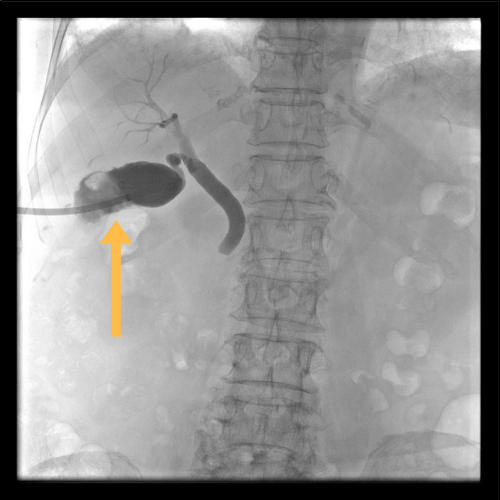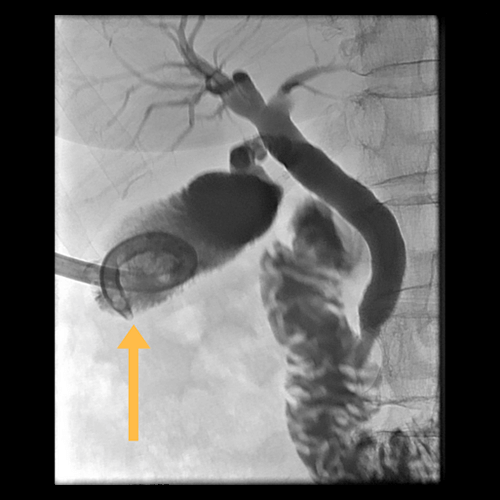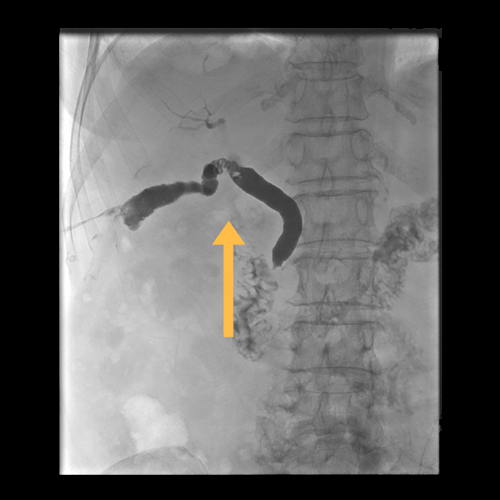Percutaneous Cholangioscopy
What is a Percutaneous Cholangioscopy procedure?
A percutaneous cholangioscopy procedure treats gallstones in the gallbladder, known as cholelithiasis, for patients who are not operative candidates for gallbladder removal. Patients with stones in the bile ducts, known as choledocholithiasis, and those who cannot undergo traditional surgery due to anatomy altering surgery.
Percutaneous cholangioscopy is performed by an interventional radiologist, a doctor who uses X-rays and other advanced imaging to see inside the body and treat conditions without surgery. The interventional radiologist’s direct visualization allows for better control of the instruments used to remove stones in comparison with fluoroscopy.
Percutaneous cholangioscopy can help in differentiating between benign and malignant masses and strictures, as well as in staging cholangiocarcinoma in the preoperative setting.
What You Need to Know
- Cholangioscopy procedures are best suited for patients who are not able to have traditional gallstone surgery or who cannot have bile duct stones removed in the standard fashion.
- Cholangioscopy is a safe and effective procedure when performed by an experienced interventionalist with an understanding of techniques to reduce complications.
- Cholangiography-guided removal of biliary or gallstones is highly successful, with complete stone removal from the gallbladder or bile ducts occurring in 80% of cases.
Why might I need a Percutaneous Cholangioscopy procedure?
-
Percutaneous cholangioscopy procedures are for patients who cannot undergo traditional surgery and
-
Have a gallbladder drainage catheter in place without the ability to have their gallbladder removed
-
Have bile duct stones which cannot be treated in a standard fashion due to surgically altered bowel/bile anatomy
Gallbladder problems may cause pain which:
-
Is usually on the right side or middle of your upper belly
-
May be constant or may get worse after a heavy meal
-
May sometimes feel more like fullness than pain
-
May be felt in your back and in the tip of your right shoulder blade
Other symptoms may include nausea, vomiting, fever, and chills. The symptoms of gallbladder problems may look like other health problems. Always see your healthcare provider to be sure.
Your healthcare provider may have other reasons to recommend a percutaneous cholangioscopy.
What happens during an Percutaneous Cholangioscopy procedure?
Percutaneous cholangioscopy is performed by making a small incision in the skin, and advancing a needle into the bile ducts or gallbladder. Iodinated contrast material is injected into the bile ducts to locate gallstones that may be causing blockage. After increasing the size of the drainage catheter over a short period (weeks) of time, the stones can then be treated with percutaneous cholangioscopy.
To access larger stones, some patients will need repeat percutaneous cholangioscopy procedures.
Larger stones can be fragmented under cholangioscopic guidance with a precisely directed laser.
On average, it takes two scope episodes to clear patients of their stones. After the stones are removed, the tube will stay in place for a couple of weeks to ensure the gallbladder/bile system is still intact and then removed.
How to Prepare:
-
You may not eat or drink eight to 12 hours prior to the procedure.
-
If you are on blood-thinning medication, ask your provider if you need to stop it prior to the procedure.
During the Procedure
-
You will be asked to change into a gown before the procedure.
-
You will be given a sedative by the anesthesiologist, who will be present to monitor your vital signs during the examination.
-
The IR doctor will go through the tube in the duodenum, a hollow jointed tube that connects the stomach to the small intestine.
After the Procedure
-
You will remain in a recovery room until most of the effect of the sedative has worn off.
-
Because of sedation used during the procedure, you’ll need to make plans to have someone take you home.
Common Side Effects
-
Discomfort at the insertion site
-
Low grade fevers
-
Nausea
The following are x-ray images of the bile ducts, showing a gallbladder with a large stone prior to and following removal by percutaneous cholangioscopy.

This picture shows a gallbladder with a large stone. The arrow points to a smaller drainage catheter that was inserted to relieve pressure. The tube size will be increased until it is a large enough dimension to treat the stone.

This image shows the gallbladder with a larger drainage catheter inserted. The larger catheter was inserted to treat the gallstone blockage. Following the percutaneous cholangioscopy procedure, the drainage catheter can be removed.

This image shows the gallbladder after the gallstone and drainage catheter’s removal.
What are the risks of an Percutaneous Cholangioscopy procedure?
Percutaneous cholangioscopy should not be performed in patients with active cholangitis otherwise known as inflamed or infected bile ducts, because of an increased risk of adjacent spread of infection as well as systemic disease from bacteria in the blood.
Potential complications include bleeding in the bilary tree (hemobilia), infection of the biliary track (cholangitis), bacteria in the blood (bacteremia), biliary drainage catheter migration or blockage, and ductal injuries like perforation and bleeding.
Next Steps
Tips to help you get the most from a visit to your interventional radiologist:
-
Before your visit, write down questions you want answered.
-
Bring someone with you to help you ask questions and remember what your provider tells you.
-
At the visit, write down the names of treatments, or tests, and any new instructions your provider gives you.
-
If you have a follow-up appointment, write down the date, time, and purpose for that visit.
-
Know how you can contact your provider if you have questions.





